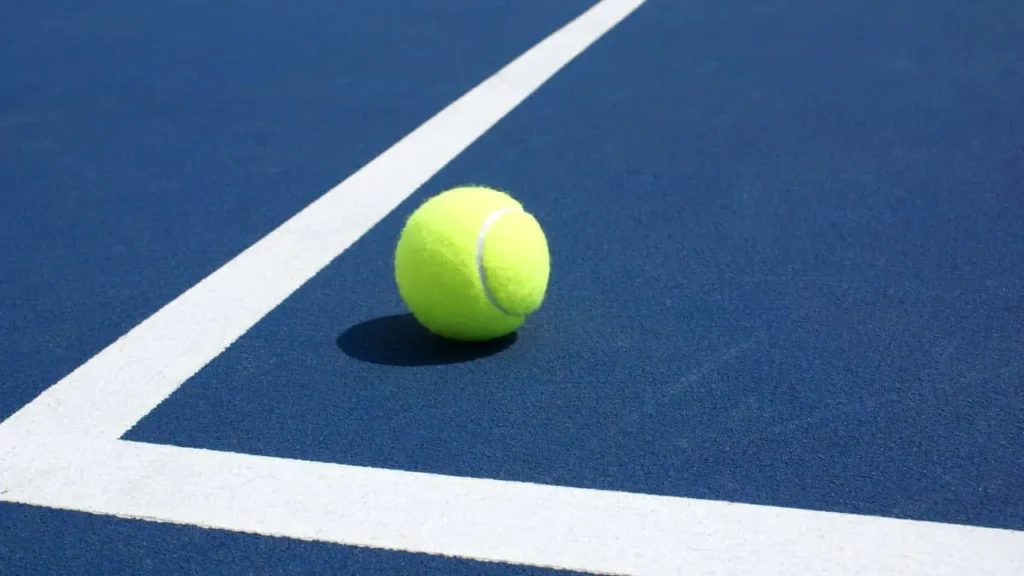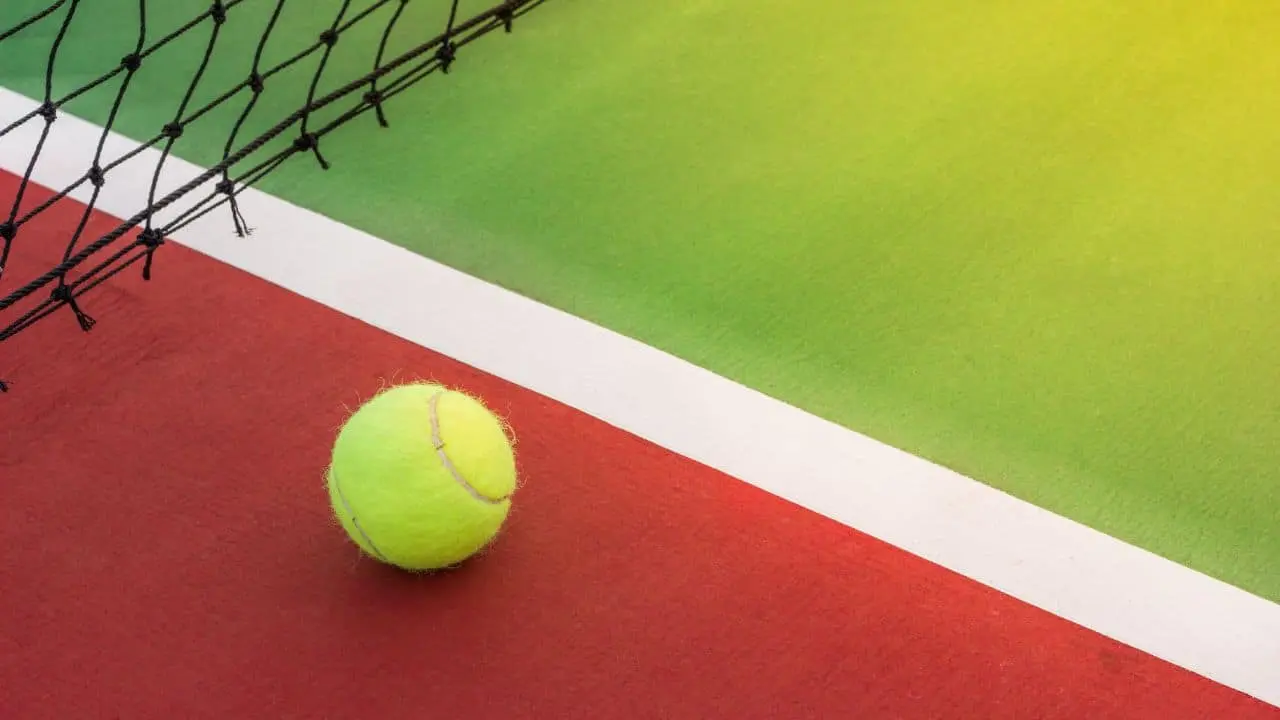Tennis balls are important parts of tennis games. Depending on the tennis ball, court surface, and intensity of play, they can last. Whether you’re a recreational or competitive player, find out how long do tennis balls last. They help to enhance your performance.
The average life of tennis balls is 2-3 weeks for regular players. But it can last 1-3 seasons for recreational players.
Pressurized or pressureless tennis balls have different lifespans. Pressurized balls changed after 2-3 seasons. In contrast, pressureless balls last several months. The court surface, storage condition, and playing intensity determine when balls wear out. To preserve internal pressure, store them somewhere cold and dry. Keep away from hot, humid conditions and direct sunshine.
Table of Contents
ToggleLifespan of Different Tennis Balls
The lifespan of tennis balls varies significantly depending on the type of ball, playing surface, and level of play. Here’s a breakdown of the typical lifespan for different types of tennis balls:
Types Of Balls | Recreational Play | Competitive Play |
Pressurized Tennis Balls | 2-3 weeks | 1-3 matches |
Pressureless Tennis Ball | 1 year or more | 2-3 matches |
Premium Pressurized | 3-6 weeks | 2-4 matches |
Training Tennis Balls | 4-6 months | 1-2 matches |
High Altitude Tennis Balls | 3-5 weeks | 3-5 matches |
Pro-Level (ATP/WTA) Balls | 6-9 games | 3-4 matches |
Factors That Affecting the Lifespan of Tennis Balls
The most obvious factor is the usage frequency of tennis balls. Frequently used balls in intense matches wear out faster than those used occasionally. A standard can of balls may last from a few hours to a few weeks, depending on frequency.
Tennis ball durability varies depending on the type of surface used. Playing on hard courts wears down tennis balls faster. The abrasive surface not only affects the felt covering. Yet, the impact on the court also promotes pressure loss in pressurized balls. Most recreational players will experience faster wear on hard courts. Tennis balls last longer on clay courts because the surface is softer. They tend to pick up a lot of clay, which can affect their bounce and weight. Grass courts are the gentlest on tennis balls, leading to a longer lifespan. Grass courts are less common than other courts.
Higher-quality tennis balls are expensive but last longer than cheap, low-quality balls. Premium brands make balls with more durable materials which expand the ball’s life.
Bad storage conditions can harm the tennis balls. They should be stored properly to maintain their pressure and performance. High temperatures, humidity, or direct sunlight lose their bounce and firmness faster. Keep them in a cool, dry place, and get benefits from storing them in a pressurized container.
Tennis balls are filled with pressurized air. They lose pressure with time, which reduces their bounce and playability. Once the internal pressure decreases, the ball’s performance deteriorates. Higher-pressure balls stay faster and bounce higher for longer.
How to Increase the Lifespan of Tennis Balls?
Use a tennis ball saver. It’s a pressurized container made to maintain consistent internal pressure in tennis balls. It extends the lifespan by keeping them at optimal pressure when not in use.
Keep tennis balls out of direct sunlight and in a cool, dry place. Avoid leaving them in hot or humid conditions, such as in a car.
To ensure even wear, rotate your tennis balls regularly. Using many balls during play helps distribute the impact across different balls. It reduces the wear on any single ball.
If possible, limit play on hard surfaces. Prefer a softer surface to reduce wear and tear on your balls.
How long do Unopened Tennis Balls Last?
Unopened tennis balls can last 2 to 4 years if stored properly. After opening, they lose their optimal bounce within a couple of weeks. Lose in bounce depends on use and storage conditions. The key factors in preserving their lifespan are:
Factors affecting shelf life
- Tennis balls stored in a cool, dry place tend to last longer. Heat and humidity allow compressed air to flow into the barrel over time, reducing shelf life.
- Humidity can also damage the packaging and affect the ball.
- Pressurized tennis balls are packed in airtight containers for storage. Some air may escape naturally over time. But if not opened, they remain in good condition for many years.
Date of Manufacturer
A tennis ball bottle has a manufacturer’s date or a “good use” date. It can be a useful indicator of when the ball was manufactured. For best performance, it is best to use the ball within a few years of this date.
Types of Tennis Balls and Their Durability

There are many types of tennis balls. Each type is well-designed for different playing styles and surfaces. Their durability varies based on the type and use case.
Pressurized tennis balls
These are the common tennis balls. These include internal air pockets to give them a high bounce and more animated play. Once they open, pressurized balls lose air and begin to bounce. For casual players, they last 1-3 matches. For professionals, they last 7-9 games. The balls become less sensitive as the air leaks over time. These are best for practice, training, or long-term recreational use.
Pressureless tennis balls
These balls do not rely on internal air pressure to maintain their bounce. These balls have a solid core. Over time, the felt wears down, but the ball will keep its bounce. Balls that are not under pressure survive a lot longer than those that are. They maintain their playability for several months. The felt on them degrades with use. They are ideal for practice sessions or casual play. These are best for clay courts, indoor courts, or softer surfaces.
Regular-duty tennis balls
Regular-duty balls are best for softer surfaces like clay or indoor tennis courts. They will stay playable for 3 to 4 sessions on clay courts but wear faster on hard courts.
Extra-duty tennis balls
Extra duty balls last longer on hard courts for 2 to 3 sessions of recreational play. They can take more wear and tear from the surface. But will still wear down faster than on clay.
High Altitude tennis balls
High-altitude tennis balls are used above 4,000 feet, where air pressure is lower. They last 1 to 3 matches at high altitudes before losing their bounce.
Training or Foam tennis balls
Foam tennis balls are for beginners, juniors, or players working on technique. These balls have a longer lifespan than standard pressurized balls. Because these have softer materials.
When Players Should Replace Tennis Balls
- When you notice that the ball has lost bounce, replace it. A ball that no longer bounces or seems flat should be swapped out.
- Check the ball’s felt covering. If it shows signs of more fraying, bald patches, or damage, it’s time to replace it. A ball with a damaged felt surface can affect your control and spin.
- A tennis ball loses internal pressure when sounds dead when hit. A healthy tennis ball should produce a consistent bounce and maintain a firm feel.
- Replace the ball if you see a drop in your performance during the game. Difficulty in controlling or changes in spin may be due to worn-out balls.
Conclusion
The kind of ball, playing surface, and use all affect How Long Do Tennis Balls Last. Though they wear out rapidly, pressured balls are ideal for contests. At the same time, pressureless balls last longer and are better suited for practice. Tennis balls have a relatively short lifespan in competitive or intense play. Recreational players can enjoy longer use by taking care of and proper storage.
FAQs
About factors like storage and surface, there are Frequently Asked Questions.
Yes, higher-quality brands tend to last longer due to better materials. Higher-quality tennis balls will perform better and last longer.
For optimal performance, replace tennis balls every 1-2 weeks if you play regularly. For less frequent players, check the balls for signs of wear and performance decline. Replace balls when they show significant wear or loss of bounce.
Store tennis balls in a cool, dry environment. Keep them in a pressurized container designed to maintain their internal pressure. Avoid leaving them in hot or humid areas, such as in a car or directly in sunlight.
Pressurized tennis balls last for 1 to 3 matches after the can is opened. They lose air and bounce over time, even if not used frequently.
Yes, court surfaces affect the wear of tennis balls. Hard courts are more abrasive, causing balls to wear out faster. The ideal surfaces for felt are clay and grass courts. They allow the balls to last longer.
Tennis balls last 1 to 3 sessions for recreational play before they lose their bounce. In competitive play, they are often replaced after 7–9 games due to higher intensity.

